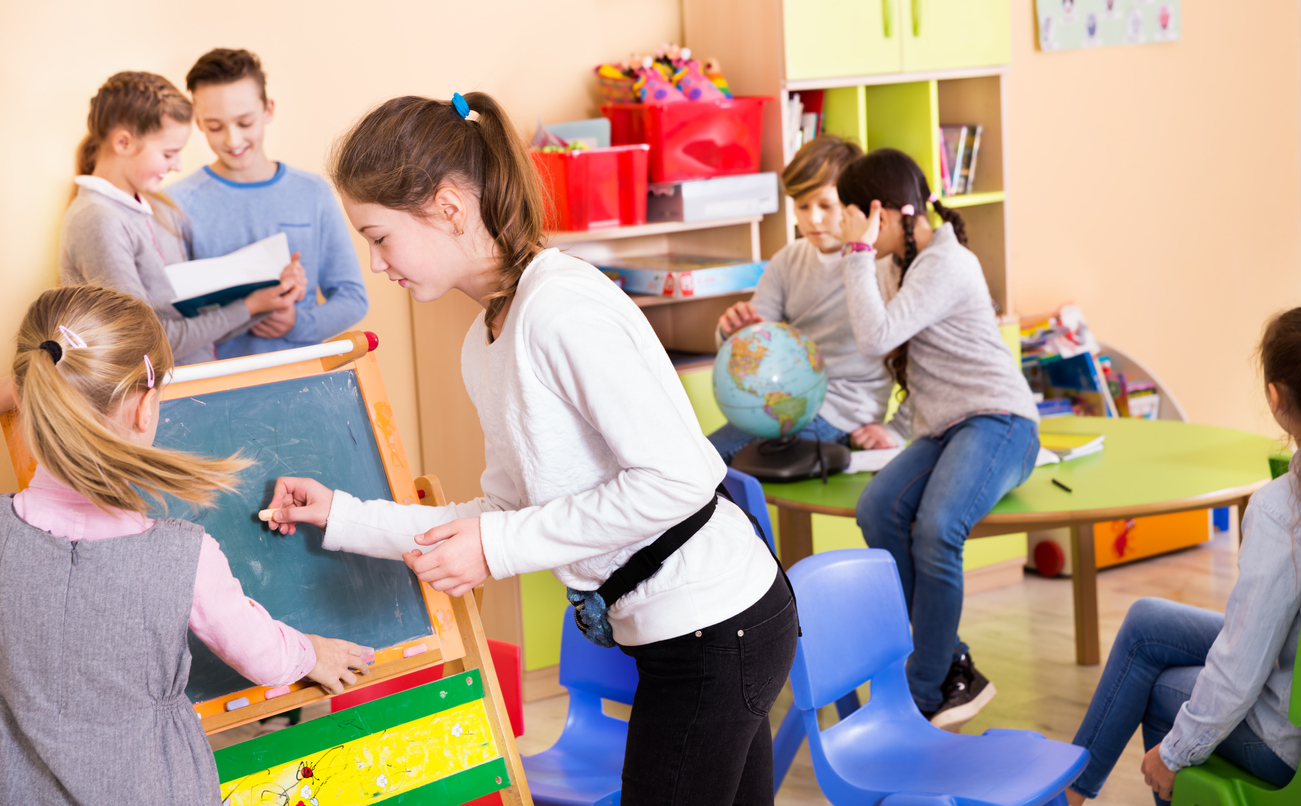
Whether you've been teaching for less than one month or more than one decade, you know that every student learns differently.
As educators, sometimes that means more than differentiating the way you teach. It means empowering your students lead some of the teaching.
That's exactly why we're diving into student-centered learning and exploring its definition, the benefits and disadvantages, as well as five tips for implementing this teaching strategy successfully.
What is student-centered learning?
Student-centered learning is an instructional approach that shifts the focus of instruction onto the students instead of the teacher.
Students take an active role in their learning experiences in this classroom setting. As students work at their own pace, they're able to learn how to:
- Build independence
- Develop transferable skills
- Become independent learners
- Communicate their understanding
- Drive their learning through inquiry
Allowing students to conduct their own learning can increase student engagement in the curriculum as they approach it through their curiosity and real-life application.
In a student-centered environment, teachers act as facilitators, guiding and encouraging students and giving students choices in their learning and assignments. Teachers are no longer the gatekeepers of information but rather a resource for students to obtain and grasp knowledge.
Students are included in the planning process, which allows personal needs to be addressed and met, while also tapping into what will motivate students to learn, participate and engage in activities.
Why student-centered learning is important

Student-centered learning is important as it focuses on individual student needs, their unique learning styles and engages them in the learning process. By focusing on students' needs, they'll also learn at their own pace and make pedagogical decisions that suit them best.
Making personalized learning a core element of a student-centered classroom opens up opportunities for more student-driven choices regarding how they'll express, share and showcase their learning.
This helps to highlight students' strengths and individuality, encourage peer-to-peer learning, and create a collaborative learning environment.
Ultimately, the more connected a student feels with what and how they are learning, the more motivated and excited they'll be to continuously learn and develop life-long skills.
What are the benefits of student-centered learning?

Teachers and students see many benefits of introducing a student-centered learning environment into their classrooms.
Increased student participation
Student-centered learning creates a collaborative environment that students are eager to participate in.
Students are encouraged to think critically about what they're learning and consider how they want to learn and demonstrate knowledge. This can involve small groups where students can learn and share knowledge.
By changing the physical arrangement of the classroom, students can feel less intimidated about sharing with their peers.
Additionally, by having more choice in the learning space and style, students will be more comfortable actively participating as they drive their learning.
Stronger relationships between teachers and students
Student-centered learning can create strong relationships between students and teachers as they learn from one another.
Teachers play the role of mentor and guide while still supporting and trusting the individual approaches, strategies, and learning decisions students make to suit their learning preferences.
Students and teachers also develop strong communication to ensure students are reaching learning goals.
Better preparation for real-world challenges
By empowering students to take ownership of their learning journey, they will learn based on their needs, learning style and interests.
Allowing students to discover different contexts around classroom topics through their lens will help them understand real-world challenges and apply their knowledge to problem solve.
Students will also bring their own personal backgrounds and knowledge to their learning creating a more inclusive classroom that acknowledges a variety of lived experiences.
Deeper understanding of how students learn best
Giving students choices in their learning environment, what and how they learn, and how they demonstrate their knowledge will help them understand how they learn best.
When students have a strong connection and understanding of their curiosity and knowledge, they are more likely to appreciate the learning process and become lifelong learners.
What are the disadvantages of student-centered learning?

While student-centered learning is important and has several benefits, teachers need to consider that introducing a student-centered learning environment will require a different approach and new strategies than one might use in a “traditional classroom.”
Harder to maintain classroom order
Teachers should be mindful that student-centered classrooms often involve students working collaboratively, discovering and discussing their learning through various strategies and approaches.
Teachers should embrace a talkative and engaged classroom while establishing classroom expectations that encourage students to take ownership and responsibility for their time, effort and learning progress.
More time lesson planning and dealing with student needs
With more personalization and student choice available in a student-centered classroom, teachers will need to organize and prepare the tools and resources students require to participate in their learning.
The planning and preparation will also need to consider the different learning paces of students in the classroom.
Teachers can carve out time to work individually with students to ensure they are tracking toward their goals while encouraging peer mentors to guide others.
Lack of resources and professional development
Making the switch to a student-centered classroom can also be challenging if teachers struggle to find adequate resources to support this transition.
Teachers shouldn’t look to shift their classrooms overnight, but learn and attend professional development to support a transition that focuses on students at the centre of their learning.
How do I implement student-centered learning in my classroom?

Now that you understand the benefits of student-centered learning and have decided to try implementing this approach in your classroom, here are five tips to get you started successfully!
1. Adopt student-centered learning gradually
Like Rome, teachers can’t adopt a new instructional approach in a day.
Take time to involve students in the decision-making, gradually preparing them and incorporating more student-centered learning opportunities into your classroom routine.
Learning centers or station rotations are great student-centered approaches that can be scaled up or down depending on how much guidance and support students may need.
Take your time to find the teaching strategies that work best for you and your students.
2. Tune in to your students' interests
Take the time to learn about what students are interested in learning.
Survey your class or have students share privately through journal entries what they are most interested in learning or discovering related to a specific topic and use these as a jumping-off point.
You can even ask students how they would like to know about particular subjects to understand their preferred learning styles.
Giving student voice a central position in the decision making process of the classroom help students to connect better and understand that the learning is centered around them.

3. Explore experiential and project-based learning
Move to a more modern instructional approach and give students the opportunity to have hands-on learning experiences.
Encourage students to pursue their curiosity and investigate the answers to real-world challenges in authentic and engaging ways.
As a teacher, take on the role of the facilitator, circulating the classroom and monitoring and guiding students. However, allow students to approach learning as they see fit.
Students may chose a trial and error approach, in-depth research, or seeking guidance from peers, and can learn how to persistently overcome challenges in a variety of ways.
4. Build lesson plans around group learning
Allow students to work collaboratively in small groups to learn, share, and problem solve together.
Create lesson plans that center around inquiry and discovery, giving groups a variety of choice in the way they can present their learning and allow them to drive the approach and strategies that they choose to uncover more knowledge and understanding around a topic or problem.
Giving the chance for students to share their learning with others will also boost their confidence and teach cooperative and collaborative skills.
5. Incorporate student reflection
Use journals or digital portfolios to have students reflect on their learning.
Ask students to share what was exciting or new about the learning experience, what they would like to dive into more deeply, or perhaps where they still need some support.
Students can even choose how they would like to reflect using, for example, an audio or video recorded reflection, a written response, or artwork.
How does technology help students learn at their own pace?

When designing a student-centered learning environment, teachers tend to rely on educational technology as a helpful tool to meet student needs.
Technology is a critical component of a student-centered classroom as it allows individual students to participate in their learning in the ways that suit them best.
Using technology permits for personalized learning connected to individual interests, so students can engage in complex questions and inquiry, while gaining comprehension of classroom concepts and practicing necessary 21st-century skills.
Finally, technology lets students meet learning outcomes at their own pace. For example, Prodigy’s adaptive algorithm detects students’ strengths and areas of opportunity and keeps students engaged by challenging them enough to develop key skills, yet intuitive enough to review prerequisite skills when a student may be struggling.
Giving room for students to work at their own pace will help to keep them engaged and highly motivated to continue learning.
How Prodigy supports student-centered learning

We support a learner-centric approach at Prodigy through our digital game-based learning platforms that personalize learning through real-time data.
Our Learner-Centric Pedagogical Approaches drive us to center the student experience within both Prodigy Math and Prodigy English.
The adaptive algorithm used in our games challenge students just enough to keep them engaged yet recognizes when a student may be struggling and will review prerequisite skills. It also gives students the chance to work at their own pace to master skills, while remaining engaged with their learning.
Our games also give students the autonomy to customize their own avatars to reflect students in their preferred way, and create an environment that helps them feel more connected to and engaged in the learning experience.

As students engage with their learning, it’s natural that they will encounter challenges. Specifically, students will encounter challenges at different times and in different ways, and it’s important to learn how to work through these challenges.
We recently took a look at perseverance in learning and found that 75% of surveyed Prodigy users have higher levels of math perseverance — a critical trait for students to adopt to support them in tackling real-world challenges as they grow.
Our mission is to help every student in the world love learning.
So, we must put students at the center of learning and continue to create personalized learning experiences.
This means giving students choices during lessons to meet unique interests and needs, and allowing teachers to take on the role of facilitator.
Only then can we can help students become the drivers of their learning journey and develop lifelong learners through engagement and motivation.











